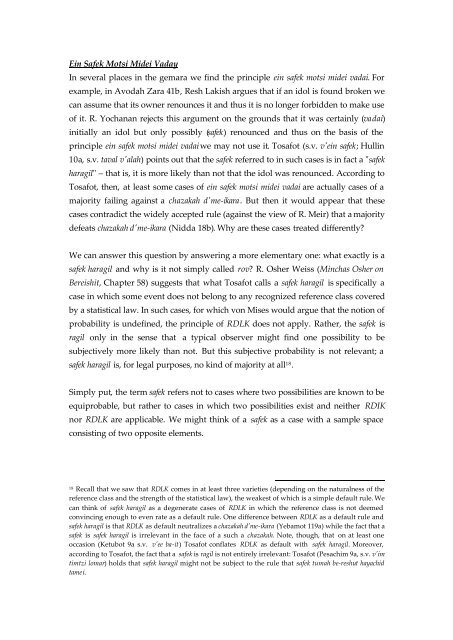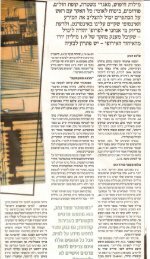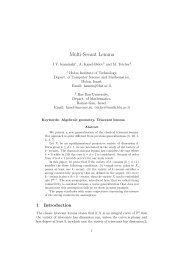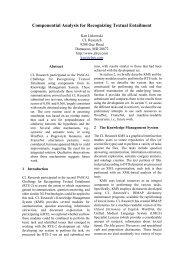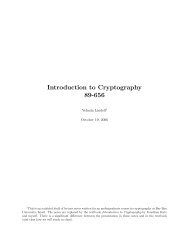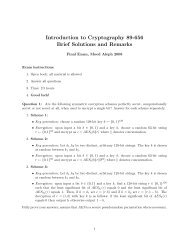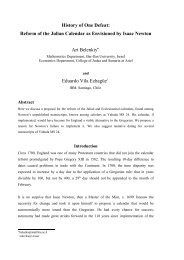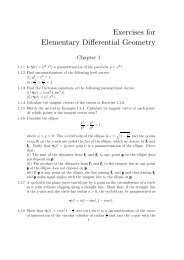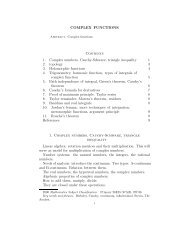Resolving Uncertainty: A Unified Overview of Rabbinic Methods
Resolving Uncertainty: A Unified Overview of Rabbinic Methods
Resolving Uncertainty: A Unified Overview of Rabbinic Methods
Create successful ePaper yourself
Turn your PDF publications into a flip-book with our unique Google optimized e-Paper software.
Ein Safek Motsi Midei Vaday<br />
In several places in the gemara we find the principle ein safek motsi midei vadai. For<br />
example, in Avodah Zara 41b, Resh Lakish argues that if an idol is found broken we<br />
can assume that its owner renounces it and thus it is no longer forbidden to make use<br />
<strong>of</strong> it. R. Yochanan rejects this argument on the grounds that it was certainly (vadai)<br />
initially an idol but only possibly (safek) renounced and thus on the basis <strong>of</strong> the<br />
principle ein safek motsi midei vadai we may not use it. Tosafot (s.v. v'ein safek; Hullin<br />
10a, s.v. taval v'alah) points out that the safek referred to in such cases is in fact a "safek<br />
haragil" – that is, it is more likely than not that the idol was renounced. According to<br />
Tosafot, then, at least some cases <strong>of</strong> ein safek motsi midei vadai are actually cases <strong>of</strong> a<br />
majority failing against a chazakah d'me-ikara. But then it would appear that these<br />
cases contradict the widely accepted rule (against the view <strong>of</strong> R. Meir) that a majority<br />
defeats chazakah d'me-ikara (Nidda 18b). Why are these cases treated differently?<br />
We can answer this question by answering a more elementary one: what exactly is a<br />
safek haragil and why is it not simply called rov? R. Osher Weiss (Minchas Osher on<br />
Bereishit, Chapter 58) suggests that what Tosafot calls a safek haragil is specifically a<br />
case in which some event does not belong to any recognized reference class covered<br />
by a statistical law. In such cases, for which von Mises would argue that the notion <strong>of</strong><br />
probability is undefined, the principle <strong>of</strong> RDLK does not apply. Rather, the safek is<br />
ragil only in the sense that a typical observer might find one possibility to be<br />
subjectively more likely than not. But this subjective probability is not relevant; a<br />
safek haragil is, for legal purposes, no kind <strong>of</strong> majority at all 18 .<br />
Simply put, the term safek refers not to cases where two possibilities are known to be<br />
equiprobable, but rather to cases in which two possibilities exist and neither RDIK<br />
nor RDLK are applicable. We might think <strong>of</strong> a safek as a case with a sample space<br />
consisting <strong>of</strong> two opposite elements.<br />
18<br />
Recall that we saw that RDLK comes in at least three varieties (depending on the naturalness <strong>of</strong> the<br />
reference class and the strength <strong>of</strong> the statistical law), the weakest <strong>of</strong> which is a simple default rule. We<br />
can think <strong>of</strong> safek haragil as a degenerate cases <strong>of</strong> RDLK in which the reference class is not deemed<br />
convincing enough to even rate as a default rule. One difference between RDLK as a default rule and<br />
safek haragil is that RDLK as default neutralizes a chazakah d'me-ikara (Yebamot 119a) while the fact that a<br />
safek is safek haragil is irrelevant in the face <strong>of</strong> a such a chazakah. Note, though, that on at least one<br />
occasion (Ketubot 9a s.v. v'ee ba-it) Tosafot conflates RDLK as default with safek haragil. Moreover,<br />
according to Tosafot, the fact that a safek is ragil is not entirely irrelevant: Tosafot (Pesachim 9a, s.v. v'im<br />
timtzi lomar) holds that safek haragil might not be subject to the rule that safek tumah be-reshut hayachid<br />
tamei.


